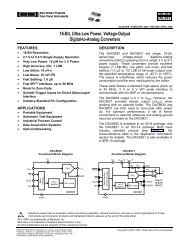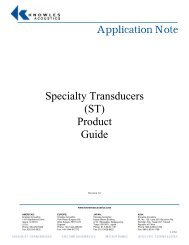AD7714* 3 V/5 V, CMOS, 500 µA Signal Conditioning ADC - dreamm
AD7714* 3 V/5 V, CMOS, 500 µA Signal Conditioning ADC - dreamm
AD7714* 3 V/5 V, CMOS, 500 µA Signal Conditioning ADC - dreamm
Create successful ePaper yourself
Turn your PDF publications into a flip-book with our unique Google optimized e-Paper software.
ANALOG FILTERING<br />
The digital filter does not provide any rejection at integer multiples<br />
of the input sampling frequency, as outlined earlier. However,<br />
due to the AD7714’s high oversampling ratio, these bands<br />
occupy only a small fraction of the spectrum and most broadband<br />
noise is filtered. This means that the analog filtering requirements<br />
in front of the AD7714 are considerably reduced<br />
versus a conventional converter with no on-chip filtering. In<br />
addition, because the part’s common-mode rejection performance<br />
of 100 dB extends out to several kHz, common mode<br />
noise in this frequency range will be substantially reduced.<br />
Depending on the application, however, it may be necessary to<br />
provide attenuation prior to the AD7714 in order to eliminate<br />
unwanted frequencies from these bands which the digital filter<br />
will pass. It may also be necessary in some applications to provide<br />
analog filtering in front of the AD7714 to ensure that differential<br />
noise signals outside the band of interest do not<br />
saturate the analog modulator.<br />
If passive components are placed in front of the AD7714, in<br />
unbuffered mode, care must be taken to ensure that the source<br />
impedance is low enough so as not to introduce gain errors in<br />
the system. This significantly limits the amount of passive antialiasing<br />
filtering which can be provided in front of the AD7714<br />
when it is used in unbuffered mode. However, when the part is<br />
used in buffered mode, large source impedances will simply<br />
result in a small dc offset error (a 10 kΩ source resistance will<br />
cause an offset error of less than 10 µV). Therefore, if the system<br />
requires any significant source impedances to provide passive<br />
analog filtering in front of the AD7714, it is recommended<br />
that the part be operated in buffered mode.<br />
CALIBRATION<br />
The AD7714 provides a number of calibration options which<br />
can be programmed via the MD2, MD1 and MD0 bits of the<br />
Mode Register. The different calibration options are outlined<br />
in the Mode Register and Calibration Sequences sections. A<br />
calibration cycle may be initiated at any time by writing to these<br />
bits of the Mode Register. Calibration on the AD7714 removes<br />
offset and gain errors from the device. A calibration routine<br />
should be initiated on the device whenever there is a change in<br />
the ambient operating temperature or supply voltage. It should<br />
also be initiated if there is a change in the selected gain, filter<br />
notch or bipolar/unipolar input range.<br />
The AD7714 gives the user access to the on-chip calibration<br />
registers allowing the microprocessor to read the device’s calibration<br />
coefficients and also to write its own calibration coefficients<br />
to the part from prestored values in E 2 PROM. This gives<br />
the microprocessor much greater control over the AD7714’s<br />
calibration procedure. It also means that the user can verify<br />
that the device has performed its calibration correctly by comparing<br />
the coefficients after calibration with prestored values in<br />
E 2 PROM. The values in these calibration registers are 24-bit<br />
wide. In addition, the span and offset for the part can be<br />
adjusted by the user.<br />
There is a significant variation in the value of these coefficients<br />
across the different output update rates, gains and unipolar/<br />
bipolar operation. Internally in the AD7714, these coefficients<br />
are normalized before being used to scale the words coming out<br />
of the digital filter. The offset calibration register contains a<br />
AD7714<br />
value which, when normalized, is subtracted from all conversion<br />
results. The full-scale calibration register contains a value<br />
which, when normalized, is multiplied by all conversion results.<br />
The offset calibration coefficient is subtracted from the result<br />
prior to the multiplication by the full-scale coefficient. This<br />
means that the full-scale coefficient is effectively a span or gain<br />
coefficient.<br />
The AD7714 offers self-calibration, system calibration and<br />
background calibration facilities. For full calibration to occur<br />
on the selected channel, the on-chip microcontroller must record<br />
the modulator output for two different input conditions. These<br />
are “zero-scale” and “full-scale” points. These points are derived<br />
by performing a conversion on the different input voltages<br />
provided to the input of the modulator during calibration. As a<br />
result, the accuracy of the calibration can only be as good as the<br />
noise level which the part provides in normal mode. The result<br />
of the “zero-scale” calibration conversion is stored in the Zero<br />
Scale Calibration Register for the appropriate channel. The result<br />
of the “full-scale” calibration conversion is stored in the<br />
Full-Scale Calibration Register for the appropriate channel. With<br />
these readings, the microcontroller can calculate the offset and<br />
the gain slope for the input to output transfer function of the<br />
converter. Internally, the part works with 33 bits of resolution<br />
to determine its conversion result of either 16 bits or 24 bits.<br />
Self-Calibration<br />
A self-calibration is initiated on the AD7714 by writing the<br />
appropriate values (0, 0, 1) to the MD2, MD1 and MD0 bits of<br />
the Mode Register. In the self-calibration mode with a unipolar<br />
input range, the zero-scale point used in determining the calibration<br />
coefficients is with the inputs of the differential pair<br />
internally shorted on the part (i.e., AIN(+) = AIN(–) = Internal<br />
Bias Voltage). The PGA is set for the selected gain (as per G2,<br />
G1, G0 bits in the Mode Register) for this zero-scale calibration<br />
conversion. The full-scale calibration conversion is performed at<br />
the selected gain on an internally-generated voltage of V REF /<br />
Selected Gain.<br />
The duration time of the calibration is 6 × 1/Output Rate. This<br />
is made up of 3 × 1/Output Rate for the zero-scale calibration<br />
and 3 × 1/Output Rate for the full-scale calibration. At this time<br />
the MD2, MD1 and MD0 bits in the Mode Register return to<br />
0, 0, 0. This gives the earliest indication that the calibration sequence<br />
is complete. The DRDY line goes high when calibration<br />
is initiated and does not return low until there is a valid new<br />
word in the data register. The duration time from the calibration<br />
command being issued to DRDY going low is 9 × 1/Output<br />
Rate. This is made up of 3 × 1/Output Rate for the zero-scale<br />
calibration, 3 × 1/Output Rate for the full-scale calibration and<br />
3 × 1/Output Rate for a conversion on the analog input. If<br />
DRDY is low before (or goes low during) the calibration command<br />
write to the Mode Register, it may take up to one modulator<br />
cycle (MCLK IN/128) before DRDY goes high to indicate<br />
that calibration is in progress. Therefore, DRDY should be<br />
ignored for up to one modulator cycle after the last bit of the<br />
calibration command is written to the Mode Register.<br />
For bipolar input ranges in the self-calibrating mode, the sequence<br />
is very similar to that just outlined. In this case, the two<br />
points are exactly the same as above but since the part is configured<br />
for bipolar operation, the output code for zero differential<br />
input is 800000 Hex in 24-bit mode.<br />
2<br />
REV. B –21–















